She knew more than the average Japanese would know about lacquer in Japan.
But it was only in Việt Nam that she started to learn this skill and create something herself.
Saeko learnt the art from painter Trịnh Tuấn, and lacquer masters Doãn Chí Trung and Lâm Hữu Chính.
“I think it's quite interesting for people who see my artwork because the material that I use is nothing different from Vietnamese artists, so the only difference is my mindset or my aesthetic, my soul or maybe my Japanese background,” she said.
She has created many beautiful lacquer works.
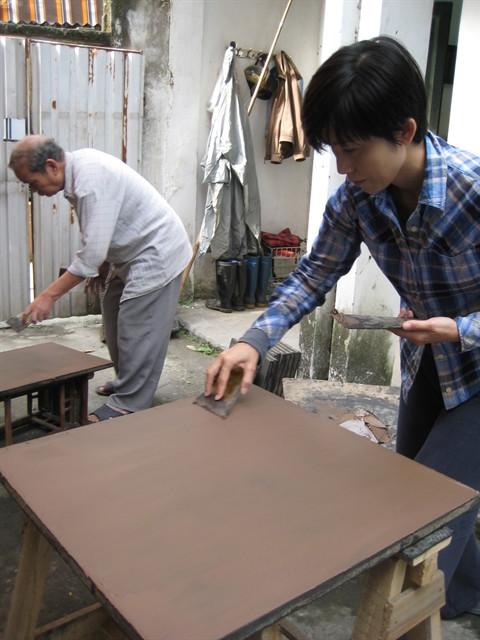 |
|
Saeko learns lacquer techniques from expert Doãn Chí Trung. Photo Courtesy of Ando Saeko |
Her latest exhibition, Moon, was a highlight of the cultural activities to celebrate the 50th anniversary of the diplomatic ties between Japan and Việt Nam.
The collection includes 10 lacquer paintings, reflecting the special bond with the moon she developed when she created the key visual for the Opera 'Princess Anio’.
The opera showcases the love story between a Vietnamese princess and a Japanese merchant in the 17th century.
The moon is used to express the nostalgia of the princess.
The opera and exhibition also mark the 50th anniversary of diplomatic relations between Việt Nam and Japan.
“It’s a story about a Vietnamese Princess marrying a Japanese merchant in the 17th century,” she said. “She married him and then moved to Japan, and because the Shogunate policy changed, she was never able to come back. So it's a love story between the two, and also the love for family and love for homeland.”
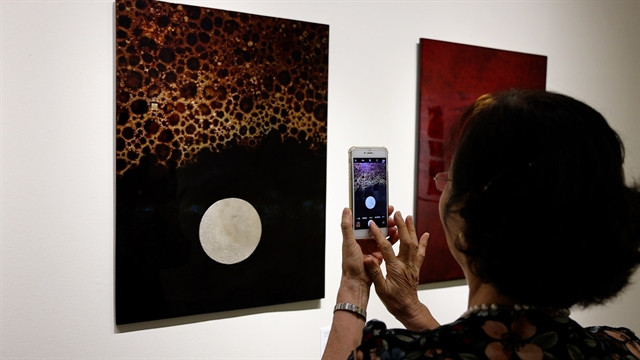 |
|
A visitor at Moon exhibition in Hà Nội. VNS Photo Minh Phương |
Saeko said when she thought of the princess’s life, all the different feelings she had and what she experienced, she thought the Moon was something of the essence that she couldn't miss.
“That made me think that the princess must have looked at the moon and thought of the one that she loved, so my attachment to the moon started there,” she said.
Saeko painted different colours, different feelings from doing the concept ‘Moon’, and she picked Waka and Tonka, traditional Japanese poems which share the same emotion with each painting that she created.
Doi Katsuma, Director of The Japan Foundation Centre which hosted her exhibition, said when it comes to art, Saeko Ando had a background in learning Vietnamese lacquer art.
“She further enriched her artworks by creating her own techniques which take inspiration from Japanese lacquer art,’’ he said. “What sets her artworks apart are not only her distinctive aesthetic sensibilities but also her appreciation for Japanese philosophy. Therefore, the artworks showcased here are not merely Vietnamese lacquer creations; they represent a captivating connection between Vietnamese and Japanese cultures.”
Her creations wowed international audiences.
Nguyễn Thị Hòa, an art lover in Hà Nội, said she found these paintings very beautiful and guessed that it took a lot of time and hard work to create these paintings.
“I feel much admiration. It's also inspiring to learn that the Japanese artist chose to work in Việt Nam,” she said.
Kohki Ohno, a tourist from Japan, said Japanese lacquer art has existed for a long time, but young people often don't care for it much.
“I think the use of natural lacquer in these artworks is not only highly effective but also incredibly beautiful,” he said.
Lifelong passion
Saeko has hosted many exhibitions all over the world, including in Japan, the UK, mainland China, Taiwan and the US.
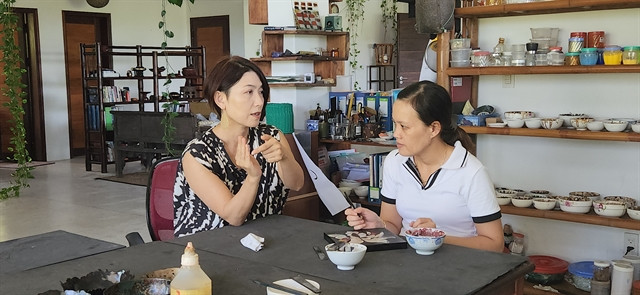 |
|
Saeko Ando shares her passion for lacquer with other people. VNS Photo Tomo Usuda |
She has chosen tranquil Hội An in the central province of Quảng Nam to live and create artworks.
She said natural scenes like rice fields, rivers and the ocean have inspired her in art.
Saeko likes sơn ta (lacquer resin) extracted from cây sơn (Toxicodendron succedaneum).
Her works are often made with many layers of lacquer resin, with colours and patterns made from various materials like gold, silver, egg shell and oyster shell.
The works are then polished in water to give them a certain shine.
She admitted that Vietnamese lacquer resin has higher transparency than that of any other natural resin.
Saeko said the older the work gets, the harder and more transparent the lacquer resin layers become, bringing brighter colours out in the work.
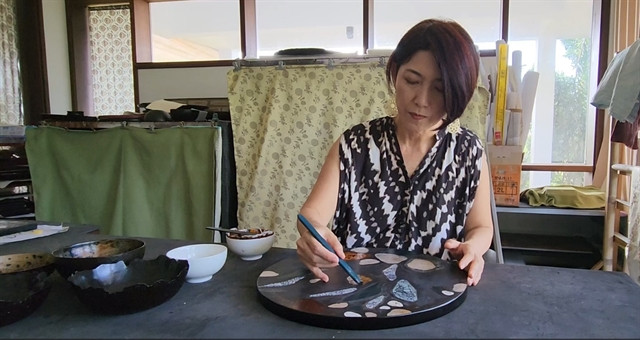 |
|
Saeko finds inspiration in Hội An's nature and people. Photo Tomo Usuda |
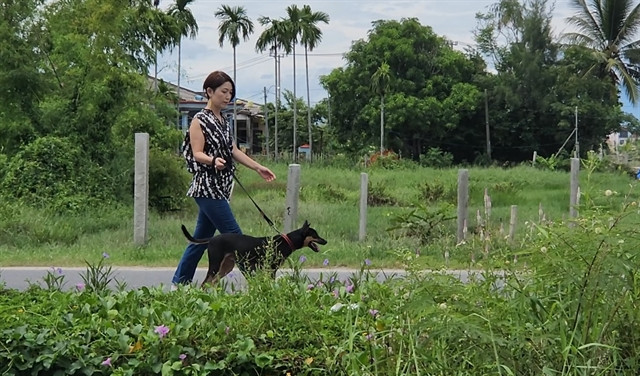 |
| She enjoys life in the tranquil countryside of Hội An. VNS Photo Tomo Usuda |
Lacquer paintings are like high quality wine, which improves as time passes.
Saeko has also become known as a researcher in the field of natural lacquer art, who often shares her findings at lectures and conferences throughout the world.
Each day the artist continues to be inspired by Vietnamese culture and people in her home in Hội An.
Saeko said Vietnamese people are tolerant, though they may be late sometimes and sing karaoke loudly. VNS